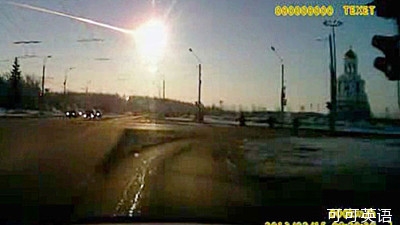Science and technology
科學技術
Dealing with asteroid strikes
應對小行星撞擊
A close shave
近地掠過
After a hit and a near miss minds are focusing on the risks from space rocks
在一次撞擊和一次近距離擦肩而過后,人們開始關注來自外太空巖石的威脅
One close shave with an asteroid is cause for excitement.
一次小行星近地掠過是一種刺激,
Two on the same day is scary.
同一天發生兩次就是驚險了。
On February 15th planet Earth experienced exactly that, as a hunk of itinerant space rock passed by extremely close.
在2月15日,行星地球正經歷了這樣的驚險:一塊流動的大塊頭太空巖石在咫尺的距離掠過地球,
While another exploded spectacularly in the skies above Russia.
而另一塊則十分壯觀得在俄國上空爆炸。
 The first asteroid, called 2012 DA14, had been known to astronomers for around a year.
The first asteroid, called 2012 DA14, had been known to astronomers for around a year.
第一顆小行星名為2012 DA14,天文學家在大約一年前發現。
They had calculated that there was no risk of collision. But the 30-metre, 190,000-tonne rock came close: 27,700Km above the surface, inside the orbit of some satellites.
他們計算出小行星的軌道,并無撞擊危險。但這枚直徑30米、重達190000噸的石塊離得是那么近:距地表27,700千米,處于一些衛星軌道內。
It was the nearest ever recorded for an asteroid that size.
對這種大小的小行星,這是有記錄以來距離最近的一次。
The second came quite literally out of a clear blue sky, appearing without warning and then disintergrating about 30 seconds later over Chelyabinsk.
第二顆在一片晴空萬里中毫無警告得出現了,約30秒后在車里雅賓斯克市上空解體了。
According to NASA, the 10,000-tonne meteor released about 500 kilotonnes of energy when it broke apart, equivalent to the yield of a largish nuclear bomb.
來自NASA的數據顯示,這顆10000噸重的隕石在肢解時釋放了大約500噸質量的能量,相當于一顆大型核彈的爆炸當量。
Only the height of the detonation-dozens of kilometers up–kept the fatality count at zero, although more than 1,000 people were injured as windows were blown out of buildings.
好在爆炸發生在數十公里的高空,未有人員死亡。雖然有超過1000人受傷,但只是被震碎的建筑物玻璃傷到。
This double whammy has focused minds on the threat from asteroids, something that astronomers have long known is real but which tends to be treated with giggles whenever it is brought outside the lab.
這次雙重晦氣已引起人們對小行星威脅的關注。長久以來天文學家們就清楚這種實實在在的威脅,但一旦在實驗室外提起就會引來哄堂大笑。
Some politicians have nevertheless taken action.
不過還是有些政客們采取了行動。
In 1998 America's Congress ordered NASA to begin cataloguing the very largest, planet killer asteroids-defined as those more than a kilometer across.
美國國會在1998年下令NASA將那些大型的行星殺手級別的小行星編入目錄,直徑超過1公里的都歸入其中。
The agency reckons it has accounted for more than 90% of them.
NASA認為超過90%的這類小行星都已記錄在案。
But as the impact from such a beast would be catastrophic, the few undiscovered rocks still represent a threat.
但是由于這種怪獸可能帶來災難性的撞擊,少部分未被發現的此類巖石仍然是個威脅。
Deep impact
深度撞擊
These days, a mix of national organizations and universities run an alphabet soup of detectors.
目前,一群來自不同國家組織和大學的研究人員開始了初步的探測。
But the field is still a bit of backwater, and budgets are tight.
但是該領域仍是一潭死水,預算很緊張。
John Tonry, an astronomer at the University of Hawaii, is building an asteroid-hunting telescope called ATLAS with $5m from NASA.
John Tonry, 一位來自夏威夷大學的天文學家,正在建造一個名為ATLAS的小行星搜索望遠鏡,NASA提供了500萬美元的經費。
Dr Tonry cannot afford to hire a proper telescope engineer, and is having to design the device himself.
博士Tonry負擔不起一個正式的望遠鏡工程師,必須親自設計這臺望遠鏡。
ATLAS is intended to spot mid-sized city killers like 2012 DA14.
ATLAS望遠鏡的目的是為了辨認出類似2012 DA14這樣中等大小的城市殺手。
Astronomers reckon the risk from these is at least as great as that from the biggest ones because there are many more of them.
天文學家估測這類小行星的威脅絕不在那些更大的小行星的威脅之下,因為數量實在太多。
Exactly how many more, though, is hard to say because, being small, they are hard to see.
不過至于準確數量卻很難說,因為他們實在太小難以被發現。
ATLAS should be able to spot a rock on a collision course a few days before it hits, giving time to organize a hasty evacuation.
ATLAS應該可以提前數天發現一塊沿著撞擊軌道運行的巖石,爭取足夠的時間組織快速疏散。
Of course, rather than evacuating the impact zone, it would be better if there were some way to deal with a threatening asteroid more directly, by nudging it into a different orbit.
當然,比起疏散撞擊區域,找到一個更直接應對小行星威脅的方法會更好,比如把小行星推入不同軌道。
Asteroid deflection suffers from a even greater giggle factor than asteroid detection, but several ideas have been proposed. One popular method is to use nuclear weapons.
讓小行星偏向的想法比小行星探測更會招致哄笑,但已經有人提出了一些主意。
Detonating a nuke near an asteroid's surface could boil away some of the rock and-by Newton's third law of motion-impart a shove in the other direction.
一個通俗的方法是使用核武器。在小行星表面附近引爆一枚核彈可以蒸發掉一些巖石質量。根據牛頓第三運動定律,還會在其他方向產生作用力。
Done early enough, this would shift the object's orbit sufficiently to stop it hitting Earth.
如果爆炸時間足夠提前,這足已改變小行星的軌道,防止與地球的撞擊。(當然這毫無意義,只是純粹在賣弄學問罷了。
Alternatively, simply ramming the offending rock might provide enough force to provoke a suitable reaction and change in orbit.
作為另一種選擇,針對來犯巖石的很普通的撞擊,也許能產生足夠的作用力引發反作用力,進而改變軌道。
The European Space Agency plans to launch, in 2015, a spacecraft called Don Quijote that will test the feasibility of doing this.
歐洲航天機構計劃在2015年發射名為堂吉訶德的太空船,以測試這種方法的可行性。
Other ideas are more elegant: painting the rock white, for instance, will alter the way it interacts with sunlight, nudging it into a new orbit.
其他的主意要優雅得多:比如把巖石表面涂成白色,這樣將改變太陽光對其的作用力,也就改變了運行軌道。
Or rocket motors might be strapped to it, to propel it in a desirable direction. Or a large spacecraft could orbit around it, where its gravity would alter the asteroid's orbit around the sun.
或者在巖石上捆綁一個火箭發動機,將其推向一個想要的方向。再或者發射一個大型太空船繞其運行,太空船的引力將會改變小行星繞太陽運轉的軌道。
The trouble is that many of these ideas rely on having plenty of warning. Even small asteroids are big, as 2012 DA14 shows.
問題在于,這里面的很多主意都依賴于充足的預警時間,即使是處理如2012 DA14般的小塊頭小行星。
That means shifting them at short notice is going to be difficult.
這就意味著,在很短的預知時間下,將很難改變他們的軌道。
When American's National Research Council studied the problem in 2010, it came to the conclusion that even nuclear weapons would require warnings times measured in years or decades.
當美國國家研究委員會在2010年研究這個問題時,得出一個結論:即使是使用核武器也需要數年甚至數十年的預警時間。
Evacuation, it said, was the only feasible option for dealing with little warning. Others are more optimistic.
委員會同時提到,在面對那些很難被辨認出而不期而至的小行星時,疏散是唯一可行的辦法。
The day before the explosion over Russia researchers at the University of California, Santa Barbara, proposed putting into orbit a solar-powered laser that could use its beam to vaporize the surface of an incoming asteroid and thus knock it off course, even at a few days' notice.
其他人要樂觀一些。就在俄國上空的爆炸發生前一天,來自圣巴巴拉加利福尼亞大學的研究人員提出一個把太陽能激光器發射到小行星軌道的方案,使用激光蒸發掉小行星表面的物質。這樣即使只有數天的預警時間,也能使其偏離軌道。
Bet your life?
用你的生命做賭注?
Hard-nosed economists might wonder whether spending money on asteroid research-either for detection or deflection-is really worth it.
精明實務的經濟學家也許會懷疑在小行星研究上投資是否物有所值,不管是小行星探測或是軌道偏移。
After all, for all their drama asteroid strikes are rare, and there are plenty of other threats to worry about.
畢竟,小行星撞擊是個非常戲劇性且罕見的,而我們還有眾多其他的威脅需要擔憂。
But the relative lack of information makes the true risk difficult to calculate.
但是由于信息的相對匱乏,真正的風險難以評估。
An asteroid strike is an event with a low probability, but a high death toll when it does happen.
小行星撞擊是低概率事件,但是一旦發生,就意味著大量的死亡。
That, as Dr Tonry points out, does funny things to risk calculations.
博士Tonry指出,這讓計算風險變得有些奇異。
Our best guess is that you can expect maybe 100 people a year to die from asteroid strikes, he says.
他說,我們最好的估算是,每年大約會有100人死于小行星撞擊,
Of course, what that really means is that you might see 100,000 death every thousand years, or 100m every million.
當然,實際上這意味著每隔數千年發生一次10萬人的死亡,或者每百萬年發生一次1億人的死亡。
After dodging two potential catastrophes in one day, the world may decide it is better to be safe than sorry.
在一天之內躲過了兩次可能的災難之后,我們的世界也許會決定,安全總比遺憾好。











